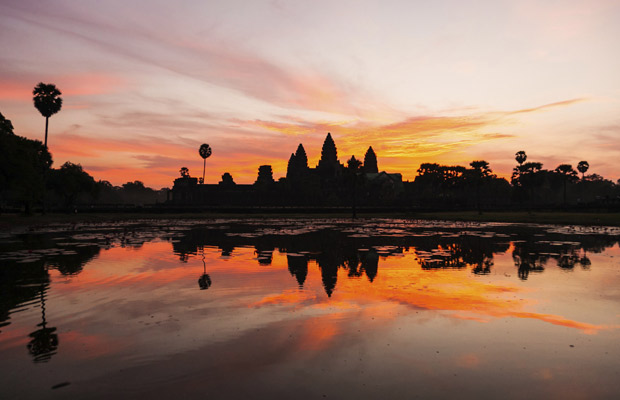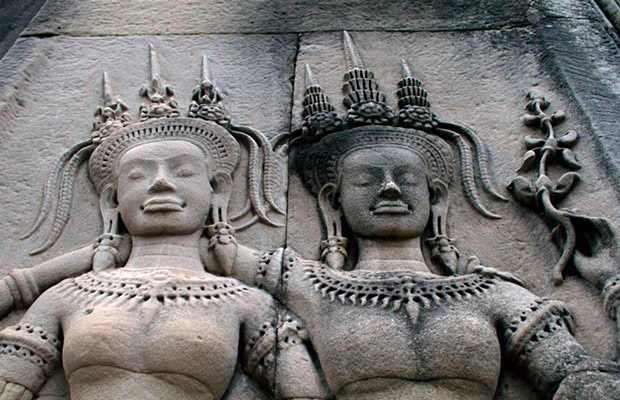Ta Keo
Ta Keo had to be the state temple of Jayavarman V, son of Rajendravarman, who had built the Pre Rup. Like Pre Rup, it has five sanctuary towers arranged in a quincunx, built at the highest level of the five-level pyramid, consisting of overlapping terraces (a pyramid of steps), surrounded by moat, as a symbolic representation of Mount Meru.
Ta Keo had to be the state temple of Jayavarman V, son of Rajendravarman, who had built the Pre Rup. Like Pre Rup, it has five sanctuary towers arranged in a quincunx, built at the highest level of the five-level pyramid, consisting of overlapping terraces (a pyramid of steps), surrounded by moat, as a symbolic representation of Mount Meru. Its particularly massive appearance is due to the absence of external decorations, since the sculpture had just begun when the works stopped, [1] as well as an elaborate use of perspective effects. It is considered an example of the so-called Khleang style.
Ta Keo Plan
The main axis of the temple is E-W and a 500-meter long causeway connects its east entrance to a landing stage in the Eastern Baray, with which Ta Keo was in a strong relationship. The outer banks of the surrounding moats, now missing, measure 255 m by 195 m.
The first terrace is 122 m by 106 m, its laterite sandstone wall constitutes the outer casing. Along the east side, there are two long galleries whose roofs were probably in wood and tile. They were lit by balustrade windows.
The second terrace is 5.5 m higher. Each of the first two terraces has a gopura at the four cardinal points. Each gopura has three independent passages and a central tower with decreasing levels.
A continuous gallery (1.4 m wide) constitutes the internal enclosure of the second terrace. It has windows only towards the interior and measures 80 m by 75 m. It is really interesting because it has no door and appears to be purely decorative, and is the first example of the Khmer gallery (along with Phimeanakas). Before Ta Keo (for example, in the Pre Rup), there were long buildings that followed the length of the enclosures with some discontinuity. [4] However, it does not have a stone vault, probably its roof was made of wood and tiles as well.
Along the east side of the second terrace in the corners, there are two buildings that are the shorter version of the long galleries of the first terrace. Further toward the central axis [5], there are two small "libraries" of sandstone, which open to the west with false windows on the upper floors.
The final pyramid rises 14 m in three narrow steps from the second terrace. Its base is 60 m squared, the summit is 47 m squared and is 21.5 m above the ground. The four ladders that lead on the ridge are continuous and very steep. At the foot of the east, there is a statue of a Nandi kneeling, which confirms that Ta Keo was a Shivaite temple. The absence of any decoration makes the final pyramid very massive. However, on the eastern side some tiles damaged by floral patterns are still visible.
The four corner towers on the summit are in basements of 0.8 m high and open to the four cardinal points with prominent lobbies. In the central tower, which dominates the others of its basement of 4 meters of height, the vestibules are doubled. Fragments of lanyards and several statues were found in the chambers of the sanctuary (about 4 meters wide) and around the towers. The central tower reaches a height of 45 meters.
History
Jayavarman V was ten years old when he got his father, Rajendravarman, in 968. His early years of reign were quite turbulent and court officials dominated royal politics. When he was seventeen years old (in 975), he began construction of his own state temple, whose modern name is Ta Keo, which was dedicated some time around 1000. In contemporary inscriptions it is called Hemagiri or Hemasringagiri ("the mountain with gold summits "). [8] It remained unfinished until the reign of Suryavarman I. [9]: 135 Yogisvarapandita, a high priest who became minister of Suryavarman I and "received" his temple many years later, says in inscriptions that a lightning attack struck the unfinished building, an evil omen, then the works stopped. Perhaps the works stopped simply because of the death of Jayavarman V, as there was a struggle for succession. In fact, the temple worked continuously as a center of worship until the 13th century, [10] and even Yogisvarapandita worshiped the shrines in the first levels of the temple.
A term closely linked to Hemasringagiri is Jayendranagari (which in Sanskrit means "capital of the victorious king"), the royal palace or perhaps the new capital of Jayavarman V. [11]: 367 [12] However, the remains of this great joint hypothesis are very scarce. Today, only one tower in the southwest survives, similar to the corner towers of Ta Keo, with an unusual single door to the south.
View Mores Temple Guide

Prasat Aur Pha On
The Orpong temple is one of the other temples in the Kulen mountains, such as Prasith Damrey Krab, Tzu Chi Chinese, etc., built on the throne of Jayavarman II. The temples are mostly built of ...
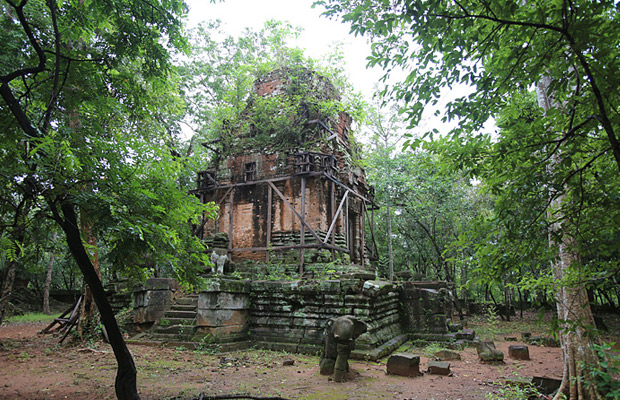
Prasat Sras Damrei
Prasat Damrei is named for the elephants guarding the four corners of the shrine ('damri' is Khmer for 'elephant'). The temple was built in honor of Shiva, which was worshiped here as a linga mounted ...
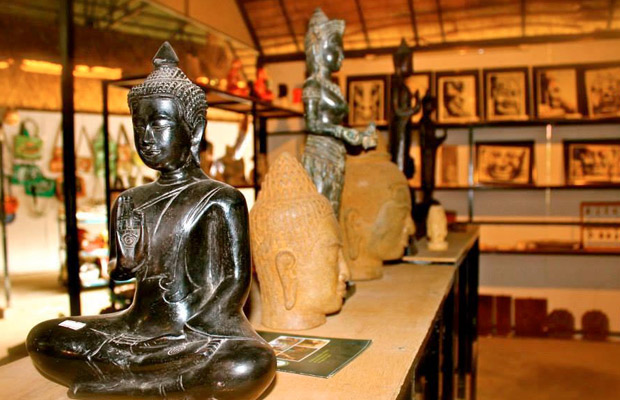
Angkor Handicraft 1
Angkor Craft 1 How to go: 1.5 km (5mn) from the provincial city. Location: Description: Location: Stoeng Village Thmey, Sung Dongkom Commune, District ...
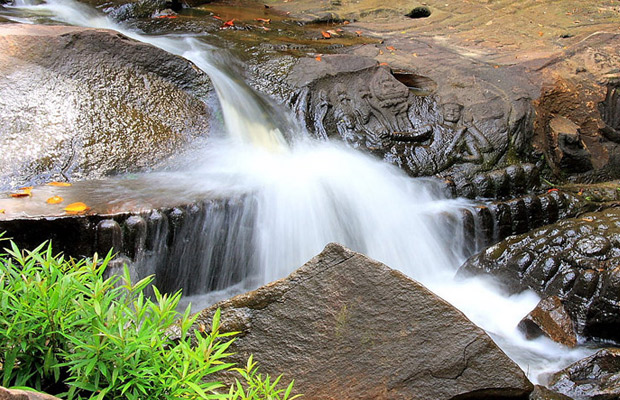
Kbal Spean
Kbal Spean is an archaeological site of the Angkorian era on the southwest slopes of the Kulen Hills, northeast of Angkor, in the Siem Reap district of Siem Reap province, Cambodia. It is situated ...
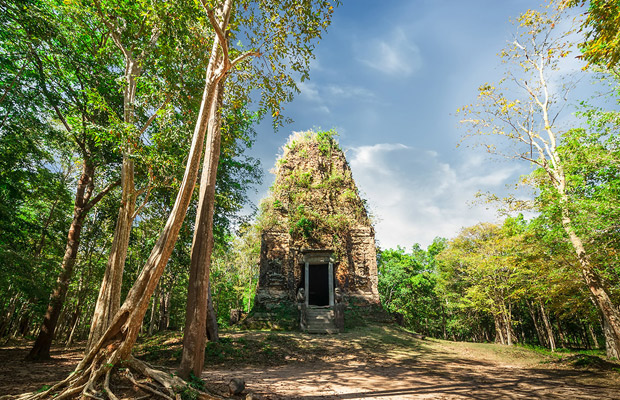
Sambor Prei Kuk
Sambor Prei Kuk (Khmer: ប្រាសាទសំបូរព្រៃគុក, Prasat Sambor Prei Kuk) is an archaeological site in Cambodia, located in the province of Kampong Thom, 30 km north ...

Lolei Temple
Lolei (Khmer: ប្រាសាទលលៃ) is the northernmost temple of the Roluos group of three Hindu temples from the late 9th century in Angkor, Cambodia, whose other members are Preah Ko and ...

Preah Vihear Temple
Preah Vihear Temple (Khmer: ប្រាសាទព្រះវិហារ Prasat Preah Vihea) is an ancient Hindu temple built during the period of the Khmer Empire, which sits atop a 525-meter ...

Angkor National Museum
During the Golden Age of the Khmer Kingdom, one of the ancient civilizations of this world was being created. It was the origin of Khmer art, culture and architecture. These great inventions have ...

Prasat Neang Khmau
Neang Khmau means the "Black Lady" in Khmer, probably referring to the fire-marked surface of the tower. Like many of the sanctuaries of Koh Ker, the temple was dedicated to ...
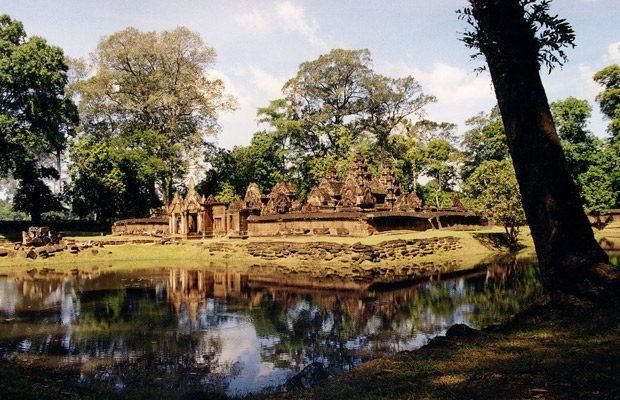
Banteay Srei Tours
The tenth-century temple of Banteay Srei is known for its intricate decoration carved in pinkish sandstone that covers the walls like tapestries. This site guarantees all the time that your schedule ...
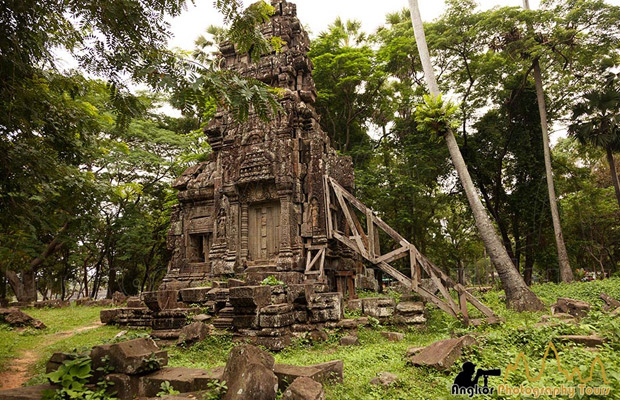
Ta Prohm Kel
Ta Prohm Kel (Khmer: Prasat Prasat or Prasat Prasat) is a small ruined sandstone monument in the archaeological park of Angkor, Siem Reap province, Cambodia. Ta Prohm Kel was one of the 102 hospital ...

Khmer Classical Dancing
The Grande Hotel in Angkor has a restaurant and stage by the river that features nightly performances of apsara style dancers. The show and dinner buffet is $ ...





